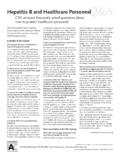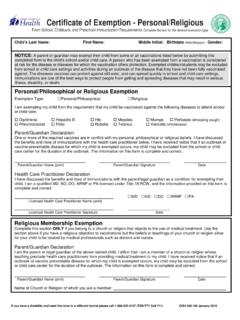Transcription of Annex 2 - WHO
1 49 Annex 2 recommendations to assure the quality, safety and efficacy of poliomyelitis vaccines (oral, live, attenuated)Replacement of Annex 1 of WHO Technical Report Series, No. 904, and Addendum to Annex 1 of WHO Technical Report Series, No. 910 Introduction 51 General considerations 52 Scope of the recommendations 58 Part A. Manufacturing recommendations Definitions General manufacturing recommendations Control of source materials Control of vaccine production Filling and containers Control tests on final lot Records Retained samples Labelling Distribution and transport Stability, storage and expiry date 80 Part B. Nonclinical evaluation of poliomyelitis vaccines (oral, live, attenuated) Characterization of a new virus submaster seed from the WHO master seed Characterization of virus working seeds from an established master seed where passage level between master seed and working seed is increased Characterization following changes in the manufacturing process 82 Part C.
2 Clinical evaluation of poliomyelitis vaccines (oral, live, attenuated) General considerations Safety and immunogenicity studies Post-marketing studies and surveillance 86 Part D. recommendations for NRAs General Release and certification by the NRA 88 Part E. recommendations for poliomyelitis vaccines (oral, live, attenuated) prepared in primary monkey kidney cells Control of vaccine production 8950 WHO Technical Report Series No. 980, 2014 WHO Expert Committee on Biological Standardization Sixty-third reportAuthors and acknowledgements 95 References 100 Appendix 1 Overview of virus seeds used in OPV production 104 Appendix 2In vivo tests for neurovirulence, and considerations in relation to assay choice 108 Appendix 3 Preparation of poliomyelitis vaccines (oral, live, attenuated) using cell banks example of a flowsheet 114 Appendix 4 Cell-culture techniques for determining the virus content of poliomyelitis vaccines (oral, live, attenuated) 116 Appendix 5 Model protocol for the manufacturing and control of poliomyelitis vaccines (oral, live, attenuated) 118 Appendix 6 Model certificate for the release of poliomyelitis vaccines (oral, live, attenuated) by NRAs 137 Appendix 7 Preparation of poliomyelitis vaccines (oral, live, attenuated)
3 Using primary monkey kidney cells example of a flowsheet 139 recommendations published by WHO are intended to be scientific and advisory in nature. Each of the following sections constitutes recommendations for national regulatory authorities (NRAs) and for manufacturers of biological products. If an NRA so desires, these WHO recommendations may be adopted as definitive national requirements, or modifications may be justified and made by the NRA. It is recommended that modifications to these recommendations be made only on condition that such modifications ensure that the vaccine is at least as safe and efficacious as that prepared in accordance with the recommendations set out below. The parts of each section printed in small type are comments or examples intended to provide additional guidance to manufacturers and 251 IntroductionWHO Requirements for oral poliomyelitis vaccine (OPV) were first formulated in 1962 (1), and revised in 1965 (2), and then again in 1971 (3), when an appendix describing the production of OPV in human diploid cells was added.
4 The Requirements were further updated in 1982 (4) following an accumulation of data, particularly on the performance and evaluation of the monkey neurovirulence test (MNVT) and tests on the karyology of human diploid cells. The Requirements for poliomyelitis vaccine (oral) were updated in full in 1989 (5) to take account of the general requirements for the characterization of continuous cell lines for the preparation of biologicals, which were adopted in 1985 (6), and after a WHO study group concluded that, in principle, such cell lines are acceptable as substrates for the production of biologicals (7). An addendum was subsequently adopted (8) that introduced changes in the tests used to confirm freedom from detectable DNA sequences of simian virus 40 (SV40); introduced the mutant analysis by polymerase chain reaction (PCR) and restriction enzyme cleavage (MAPREC) assay as an optional additional in vitro test for poliovirus type 3; increased levels of laboratory containment for wild polioviruses (WPVs) (9).
5 And provided guidance on additional antibody screening tests (for foamy viruses) for animals from closed primate colonies used as a source for primary monkey kidney Requirements (now recommendations ) were last revised in full in 1999 (10) when the use of transgenic mice expressing the human poliovirus receptor (TgPVR21 mice) (11) as an alternative to the MNVT for type-3 virus was included in the revision, and the MAPREC test was introduced as the in vitro test of preference for the evaluation of filtered bulk suspensions for poliovirus type 3 (12). The previously mandated reproductive capacity at elevated temperature (rct40) test then became an optional, additional test. The studies with poliovirus types 1 and 2 in TgPVR21 mice were completed by June 2000, and an addendum to the WHO recommendations for the production and control of poliomyelitis vaccine (oral) was adopted in 2000 (13) that included the neurovirulence test in TgPVR21 mice as an alternative to the MNVT for all three poliovirus then, advances in scientific knowledge have been made, novel laboratory techniques have become available and new vaccine formulations (such as monovalent and bivalent OPV) are being used.
6 In 2008, the WHO Expert Committee on Biological Standardization advised that the recommendations for OPV should be revised. In addition, various tests are now applicable to all three types of polioviruses, and their significance needs to be better explained and rationalized. Sections on the nonclinical and clinical evaluation of new candidate OPVs are also required. To facilitate this process, WHO convened a working group to initiate the revision of the recommendations for the production and control of OPV, as outlined in WHO Technical Report Series No. 904 and 52 WHO Technical Report Series No. 980, 2014 WHO Expert Committee on Biological Standardization Sixty-third reportNo. 910. Experts from academia, national regulatory authorities (NRAs), national control laboratories (NCLs) and industry involved in the research, manufacture, authorization and testing or release of OPV from countries around the world met from 20 22 July 2010 to identify and discuss the issues to be considered in revising Technical Report Series No.
7 904 and No. 910 (14).The major issues addressed during this revision process included: updating information on the origin of different strains for OPV production, and the addition of a new Appendix 1; updating the section on international standards and reference preparations; updating the section on general manufacturing recommendations and control tests; updating information on neurovirulence tests in monkeys (MNVTs) and in transgenic mice (TgmNVTs), and on the MAPREC test, which is extended to all three types of seeds and bulks; a new Appendix 2, giving rationales for the choice of monkey or mouse neurovirulence tests; consideration of new vaccine formulations (monovalent OPV and bivalent OPV); an update on terminology, and the introduction of the virus submaster seed lot , which is applicable only to the master seed supplied by WHO; inclusion of new sections on the nonclinical and clinical evaluation of OPV.
8 Updating the appendices; updating the standard operating procedures (SOPs) for TgmNVTs and MAPREC assays, and for new MNVTs in light of technical changes have been made to bring the document into line with other WHO recommendations published since the last considerationsPoliomyelitis is an acute communicable disease of humans caused by three distinct poliovirus serotypes (types 1, 2 and 3) distinguishable by a neutralization test (15). Poliovirus is a species C human enterovirus of the Picornaviridae family, and is composed of a single-stranded, positive-sense RNA genome and a protein 253 Where sanitation is poor, these viruses are believed to be spread mainly by faecal-to-oral transmission, whereas the oral-to-oral mode of transmission probably dominates in settings with higher standards of sanitation. However, in most settings, mixed patterns of transmission are likely to occur.
9 In the pre-vaccine era, roughly one in 200 susceptible individuals infected by polioviruses developed paralytic poliomyelitis (15).Progress in polio control (and, since 1988, polio eradication) has occurred mainly due to the widespread use of vaccines. An inactivated poliomyelitis vaccine (IPV Salk vaccine) was licensed in 1955; live-attenuated OPV (Sabin vaccine) was licensed as a monovalent OPV (mOPV) in 1961, and as a trivalent OPV (tOPV) in 1963. The Sabin strains of poliovirus used in the production of OPV were shown to be both immunogenic and highly attenuated when administered orally to susceptible children and adults. Most countries that initially introduced vaccination with IPV later changed to OPV because OPV provided many advantages, including easier administration, suitability for mass vaccination campaigns, superior induction of intestinal mucosal immunity, and lower production costs.
10 In 1974, OPV was recommended as part of the Expanded Programme on Immunization, and OPV was again the vaccine of choice in 1988 when the World Health Assembly resolved to eradicate polio globally by the year 2000. By 2010, three of the six WHO Regions had been certified as free of WPVs, and WPV2 has not been detected worldwide since 1999 (15).In addition to tOPV, which is used in many countries for routine or supplementary vaccination, monovalent OPV against type 1 (mOPV1) and against type 3 (mOPV3), and bivalent OPV against type 1 and type 3 (bOPV) (15), as used by the Global Polio Eradication Initiative (GPEI) have been licensed for use in endemic countries or for outbreak control in situations where one or two types may re-emerge. In addition, mOPV against type 2 has been licensed but is expected to be used primarily for emergency response stockpiles. In 2012, the Strategic Advisory Group of Experts on Immunization was asked by WHO to consider the possibility of replacing tOPV with bOPV for routine immunization the introduction and widespread use of mOPV1 and mOPV3 in supplementary immunization activities in 2005, the GPEI reported substantial reductions in these poliovirus types.














